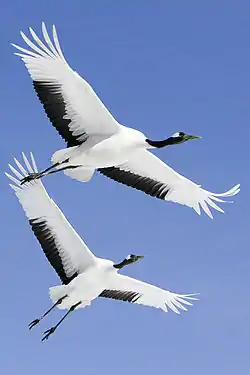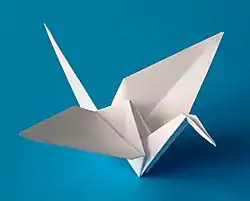鶴
| ||||||||
 | ||||||||
| ||||||||
Translingual
Han character
鶴 (Kangxi radical 196, 鳥+10, 21 strokes, cangjie input 十土竹日火 (JGHAF) or 人土竹日火 (OGHAF), four-corner 47227, composition ⿰隺鳥)
References
- KangXi: page 1496, character 20
- Dai Kanwa Jiten: character 47185
- Dae Jaweon: page 2026, character 10
- Hanyu Da Zidian (first edition): volume 7, page 4654, character 3
- Unihan data for U+9DB4
- Unihan data for U+FA2D
Chinese
| trad. | 鶴 | |
|---|---|---|
| simp. | 鹤 | |
| alternative forms | 鸖 䳽 隺 | |
Glyph origin
| Old Chinese | |
|---|---|
| 鶴 | *ɡloːwɢ |
| 髉 | *pqroːwɢ |
| 篧 | *skroːwɢ, *sɡroːwɢ |
| 榷 | *kroːwɢ |
| 搉 | *kroːwɢ, *kroːwɢ, *kʰroːwɢ |
| 傕 | *kroːwɢ |
| 確 | *kʰroːwɢ |
| 寉 | *ɡluːwɢ |
| 蒮 | *luwɢ |
Phono-semantic compound (形聲, OC *ɡloːwɢ) : phonetic 寉 (OC *ɡluːwɢ) + semantic 鳥.
Etymology
Possibly from Austroasiatic (Schuessler, 2007). Compare Proto-Mon-Khmer *kl(uə)k (“white”), whence Proto-Vietic *t-lɔːk (“white”) but Old Mon kloh (“crane”).
Pronunciation
Definitions
鶴
- crane (bird)
- white
- a surname
Compounds
|
|
|
Japanese
Kanji
(common “Jōyō” kanji)
Readings
- Go-on: がく (gaku)
- Kan-on: かく (kaku)
- Kun: つる (tsuru, 鶴, Jōyō)←つる (turu, historical); たず (tazu, 鶴)←たづ (tadu, historical)
- Nanori: ず (zu); つ (tsu)
Etymology 1
| Kanji in this term |
|---|
| 鶴 |
| つる Grade: S |
| kun’yomi |



Given a crane's long neck and how the bird hunts, possibly related to 蔓 (tsuru, “vine”); 弦 (tsuru, “bowstring; musical instrument string”); 釣る, 吊る (tsuru, “to hang down; to string up; to fish”). Given how cranes flock together, possibly related also to 連る (tsuru), older root form of modern verb 連れる (tsureru, “to accompany”). That said, 連る also appears to ultimately derive from 蔓 (tsuru, “vine”).
Vovin (2008) considers it possibly related to an ancestor of Korean 두루미 (durumi, “crane”), with a root-final -m vanishing later, leaving only a Kansai accent pattern behind.[1] May ultimately be a regional Wanderwort. Compare also Proto-Turkic *turunya (“crane”) (whence Turkish turna), Mongolian тогоруу (togoruu, “crane”), Hungarian daru (“crane”).
The reading tsuru is first seen used to mean “a crane” from the late Heian period. Prior to that time, the only reading used for the bird was tazu. However, the kanji 鶴 was used in the Man'yōshū (759 CE) as a 借訓 (shakkun) reading for つる (turu → tsuru), the 連体形 (rentaikei, “attributive form”) of つ (tu → tsu, auxiliary verb of affirmation, certainty, or completion), suggesting that tsuru may have already existed as an everyday term meaning “a crane”.[2]
Pronunciation
- (Tokyo) つる [tsúꜜrù] (Atamadaka – [1])[3][4]
- IPA(key): [t͡sɨᵝɾɯ̟ᵝ]
Noun
鶴 • (tsuru)
- a crane (large, long-legged and long-necked bird of the familyGruidae)
- Short for 折鶴 (orizuru): a paper crane, the archetypical origami design
- Short for 鶴嘴 (tsuruhashi): a pickaxe
- a 家紋 (kamon, “family crest”) depicting a crane
- (euphemistic) white hair
- Synonym: 白髪 (shiraga)
- a decoration made of straws and reeds in the form of two cranes, used during the 14th year of the first month in the former town of Sakurajima, Kagoshima Prefecture
Usage notes
As with many terms that name organisms, this term is often spelled in katakana, especially in biological contexts (where katakana is customary), as ツル.
Derived terms
- 鶴岡 (Tsuruoka)
- 鶴ヶ城 (Tsurugajō)
- 鶴亀 (tsurukame)
- 鶴首, 鶴頸 (tsurukubi)
- 鶴三 (Tsuruzō)
- 鶴の戒め (tsuru no imashime)
- 鶴の毛衣 (tsuru no kegoromo)
- 鶴の子 (tsurunoko)
- 鶴の孫 (tsuru no mago)
- 鶴の丸 (tsuru no maru)
- 鶴脛 (tsuruhagi)
- 鶴嘴 (tsuruhashi)
- 鶴斑 (tsurubuchi)
- 鶴擬 (tsurumodoki)
- 鶴屋 (Tsuruya)
- 姉羽鶴 (anehazuru)
- 折鶴 (orizuru)
- 鸛鶴 (kōzuru)
- 白鶴 (shiratsuru)
- 千羽鶴 (senbazuru)
- 黒鶴 (kurozuru)
- 丹頂鶴 (tanchōzuru)
- 友鶴 (tomozuru)
- 鍋鶴 (nabezuru)
- 引き鶴 (hikizuru)
- 紅鶴 (benizuru)
- 真鶴, 真名鶴 (manazuru)
- 万羽鶴 (manbazuru)
- 夕鶴 (yūzuru)
- 夜の鶴 (yoru no tsuru)
Idioms
- 鶴来る (tsuru kitaru)
- 鶴の一声 (tsuru no hitokoe)
- 凍て鶴 (itezuru, “frozen crane → a metaphor for something stock still and unmoving, from the way a crane will freeze when hunting”)
- 子を思う鶴 (ko o omō tsuru)
- 塵塚に鶴 (chirizuka ni tsuru)
- 掃き溜めに鶴 (hakidame ni tsuru)
Proverbs
- 鶴九皐に鳴き声天に聞こゆ (tsuru kyūkō ni naki koe ten ni kikoyu)
- 鶴は千年亀は万年 (tsuru wa sennen kame wa mannen)
Proper noun
鶴 • (Tsuru)
- a female given name
- a surname
Etymology 2
| Kanji in this term |
|---|
| 鶴 |
| たず Grade: S |
| kun’yomi |
| Alternative spelling |
|---|
| 田鶴 |
/tadu/ → /tad͡zu/ → /tazu/
From Old Japanese.[2][3]
Speculatively, this could be analyzed as a compound of た (ta, possibly 田 (“rice paddy”), where cranes are known to hunt) + つ (*tsu, uncertain, possibly “a large bird”), wherein the tsu changes to dzu, modern zu, as an instance of rendaku (連濁). This tsu may be the tsu in modern tsuru above. (Can this(+) etymology be sourced?)
Pronunciation
- Kun’yomi
- (Tokyo) たず [táꜜzù] (Atamadaka – [1])[3]
- IPA(key): [ta̠zɨᵝ]
Noun
鶴 • (tazu) ←たづ (tadu)?
- (archaic, poetic) a crane (large, long-legged and long-necked bird of the familyGruidae)
Usage notes
This reading is now reserved for poetry.[2][3]
Derived terms
- 葦田鶴 (ashi tazu, “crane”, poetic; literally “reed crane” in reference to the way the birds will often hide among the reeds)
Etymology 3
| Kanji in this term |
|---|
| 鶴 |
| かく Grade: S |
| on’yomi |
From Middle Chinese 鶴 (MC ɦɑk̚).
Compare modern Mandarin 鶴 (hè).
Affix
鶴 • (kaku)
- crane (large bird of the familyGruidae)
- cranelike
Derived terms
- 鶴駕 (kakuga)
- 鶴禁 (Kakkin)
- 鶴膝 (kakushitsu)
- 鶴首 (kakushu)
- 鶴寿 (kakuju)
- 鶴書 (kakusho)
- 鶴氅 (kakushō)
- 鶴髪 (kakuhatsu)
- 鶴望 (kakubō)
- 鶴翼 (kakuyoku)
- 鶴林 (Kakurin)
- 鶴唳 (kakurei)
- 雲鶴 (unkaku)
- 亀鶴 (kikaku)
- 群鶴 (gunkaku)
- 玄鶴 (genkaku)
- 皐鶴 (kōkaku)
- 皓鶴 (kōkaku)
- 西鶴 (Saikaku)
- 白鶴 (hakkaku)
- 夜鶴 (yakaku)
Idioms
- 鶏群の一鶴 (keigun no ikkaku)
References
- Bjarke Frellesvig and John Whitman, editors (2008), chapter 7, in Proto-Japanese: Issues and Prospects, Amsterdam; Philadelphia: John Benjamins Publishing Company, Proto-Japanese beyond the accent system, pages 140-156
- 1988, 国語大辞典(新装版) (Kokugo Dai Jiten, Revised Edition) (in Japanese), Tōkyō: Shogakukan
- 2006, 大辞林 (Daijirin), Third Edition (in Japanese), Tōkyō: Sanseidō, →ISBN
- 1998, NHK日本語発音アクセント辞典 (NHK Japanese Pronunciation Accent Dictionary) (in Japanese), Tōkyō: NHK, →ISBN
Korean
Etymology
From Middle Chinese 鶴 (MC ɦɑk̚).
| Historical Readings | ||
|---|---|---|
| Dongguk Jeongun Reading | ||
| Dongguk Jeongun, 1448 | ᅘᅡᆨ〮 (Yale: hhák) | |
| Middle Korean | ||
| Text | Eumhun | |
| Gloss (hun) | Reading | |
| Hunmong Jahoe, 1527 | 학〮 (Yale: hák) | 학〮 (Yale: hák) |
Pronunciation
- (SK Standard/Seoul) IPA(key): [ha̠k̚]
- Phonetic hangul: [학]
Hanja
Wikisource鶴 (eumhun 두루미 학 (durumi hak))
- Hanja form? of 학 (“crane (bird)”). [noun]
Compounds
- 금학 (琴鶴, geumhak)
- 노학 (老鶴, nohak)
- 백학 (白鶴, baekhak)
- 선학 (仙鶴, seonhak)
- 운학 (雲鶴, unhak)
- 청학 (靑鶴, cheonghak)
- 학가 (鶴駕, hakga)
- 학려 (鶴唳, hangnyeo)
- 학반 (鶴班, hakban)
- 학발 (鶴髮, hakbal)
- 학수 (鶴壽, haksu)
- 학수 (鶴首, haksu)
- 학슬 (鶴膝, hakseul)
- 학익 (鶴翼, hagik)
- 학정 (鶴頂, hakjeong)
- 현학 (玄鶴, hyeonhak)
- 홍학 (紅鶴, honghak)
References
- 국제퇴계학회 대구경북지부 (國際退溪學會 大邱慶北支部) (2007). Digital Hanja Dictionary, 전자사전/電子字典.
Kunigami
Kanji
鶴
Readings
- Kun: ちるー (chirū, 鶴)
Okinawan
Kanji
(common “Jōyō” kanji)
Readings
- Kun: ちる (chiru, 鶴)
Etymology
| Kanji in this term |
|---|
| 鶴 |
| ちる Grade: S |
| kun’yomi |
Cognate with Japanese 鶴 (tsuru).
Pronunciation
- (Shuri-Naha) ちる[chíꜜrù] (Kakō - [1])[1]
- IPA(key): [t͡ɕiɾu]
Noun
鶴 (hiragana ちる, rōmaji chiru)
- a crane (large, long-legged and long-necked bird of the familyGruidae)
Derived terms
- 鶴ん鳥 (chiruntui), 鶴ん鳥 (chirintui), to avoid confusion with 弦 (chiru, “bowstring”)
References
- “チル” in Okinawa Center of Language Study, Shuri-Naha Dialect Dictionary.
Old Japanese
Etymology
Possibly a compound of 田 (ta, “rice paddy”, where cranes are known to hunt) + つ (*tu, uncertain, possibly “a large bird”). (Can this(+) etymology be sourced?)
Noun
鶴 (tadu) (kana たづ)
- a crane (large, long-legged and long-necked bird of the familyGruidae)
- 711–712, Kojiki (poem 85)
- 阿麻登夫登理母都加比曾多豆賀泥能岐許延牟登岐波和賀那斗波佐泥
- ama-to2bu to2ri mo2 tukapi1 so2 tadu ga ne no2 ki1ko2yemu to2ki1 pa waga na to1pasane
- (please add an English translation of this usage example)
- c. 759, Man'yōshū (book 7, poem 1199), text here
- 藻苅舟奧榜來良之妹之嶋形見之浦爾鶴翔所見
- mokari-bune oki1 ko2gi1kurasi Imogasima Katami1-no2-ura ni tadu kake2ru mi1yu
- Rowing the seaweed-gathering boat out to sea and back again, I saw the cranes soaring by Katami inlet on Imogashima.
- For more quotations using this term, see Citations:鶴.
- 711–712, Kojiki (poem 85)
Quotations
For quotations using this term, see Citations:鶴.
Derived terms
- 鶴が音 (tadu ga ne)
- 鶴群 (tadumura)
- 蘆鶴 (asitadu)
Descendants
- Japanese: 鶴 (tazu)
Vietnamese
Han character
鶴: Hán Nôm readings: hạc
- This term needs a translation to English. Please help out and add a translation, then remove the text
{{rfdef}}.